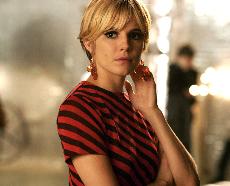
Lou Reed blasted the script as filming began. Bob Dylan delayed the release on the grounds that he was unfairly portrayed in the movie. And of course, then came the “real” sex-scene rumors, a thinly veiled publicity stunt to attract audiences. It seems fitting that a film on sixties icon Edie Sedgwick should generate media buzz, but in the end, Factory Girl deserves neither lashings nor praise – a mild shrug would suit it just fine.
In director George Hickenlooper’s (Mayor of Sunset Strip) biopic, Andy Warhol’s factory days are recreated through the eyes of Sedgwick, who narrates her story from a Santa Barbara drug-rehab center in 1970. In a display that tends to favor the “pop” in pop art, Hickenlooper channels all the appropriate style. The look is perfect, from the foil-covered factory to the color-adjusted cinematography, and the period soundtrack (complete with an adequate Velvet Underground reenactment) completes the feel. The production team hones in on Warhol’s bizarre, artsy universe, but the script rarely does its surroundings any real justice. Vapid discussions on art, idolatry and America never amount to anything more than half-baked themes put on the back burner for the more familiar biopic elements.
What makes Factory Girl bearable, and even enjoyable, is its terrific leads. As Sedgwick, Sienna Miller (Layer Cake) transcends the E! True Hollywood Story retelling and delivers a heartfelt portrayal of Warhol’s fallen muse. Under the pale makeup and dark sunglasses, Guy Pearce (The Proposition) proves his versatility as the man holding the strings, Mr. Warhol himself. Both actors provide the film with its liveliness, and without them, the film could have been disastrous.
From the beginning, Factory Girl must be taken with a grain of salt. It often adopts a documentary style, but beware – the facts have been tampered with. Sedgwick’s life was full of dark mysteries and unconfirmed encounters, and any script would have had to fill in the gaps. However, it is a shame that the scribes at work behind Factory Girl had to choose all of the most obvious explanations: Drugs, sex and mental illness, here we come.
Rejecting her historical bloodline and old-money upbringing (one of Sedgwick’s ancestors signed the Declaration of Independence), Edie flees art school in Santa Barbara to meet her friend Chuck (Jimmy Fallon, Taxi) in the Big Apple. At an art gallery, Warhol becomes smitten with Sedgwick, taking her in as a part of the factory crew and promising to make her a superstar.
In a fluttering of clicking cameras and fast-paced cuts, Sedgwick and Warhol explode into the spotlight.
For all the scripted missteps (notably the hokey, all-too-literal flashbacks to Edie’s troubled childhood memories), the scriptwriting team gives an interesting examination of the pull-and-tug relationship between Warhol and his starlet. Did Warhol really exploit Sedgwick, was he another back-stabbing father-figure in her life, or did he truly love her? The filmmakers leave this, and little else, to our consideration.
The complex personalities of those portrayed (especially those of Warhol and Sedgwick) get mixed in with too much fiction. They become predictable, skin-deep characters that only escape ennui thanks to the talented performers enlisted to give them life.
But then, there is the Dylan issue.
At the peak of Edie’s fame and the onset of her historical drug abuse, an old friend (perhaps based on Dylan associate Bob Neuwirth) introduces her to a musician (Hayden Christensen, Star Wars Episode III: Revenge of the Sith), a famous folk singer whose name we are never given. He wears a scarf around his neck and black sunglasses to cover his eyes, smokes a cigarette and speaks with an unmistakable voice.
Oh, and he digs motorcycles and harmonicas too.
The man is obviously Bob Dylan, yet Hickenlooper claims the musician is a composite character (a combination of Dylan, Jim Morrison, Donovan and Mick Jagger, though only Dylan is really visible in the character), despite reports that early versions of the script had the character named “Bob Dylan.”
Christensen’s take on the Dylan look-alike is weak, a frail imitation of the legendary man. The Musician With No Name moves in to whisk Edie away from Andy’s superficial world, spouting off cheesy Dylan-esque dribble all the while, such as “nothing is real.” The romance (aspects of which Dylan has angrily refuted) strains Sedgwick’s place in Warhol’s inner circle. The falling-out hits hard, and Hickenlooper dedicates the remainder of Factory Girl to Sedgwick’s painful deterioration.
Factory Girl, for all its follies and disputed inaccuracies, gives a mostly entertaining, sad glimpse into the life of a lonely woman with whom America once had an infatuation. However, the film hesitates to peek behind either her isolation or the public’s fixation on her – as with many biopics, it is a biased, by-the-numbers rehashing of a fractured life with little room allotted for introspection.
Simply put, Edie deserved something better.
Contact reporter Zachary Herrmann at zherrm@umd.edu.



